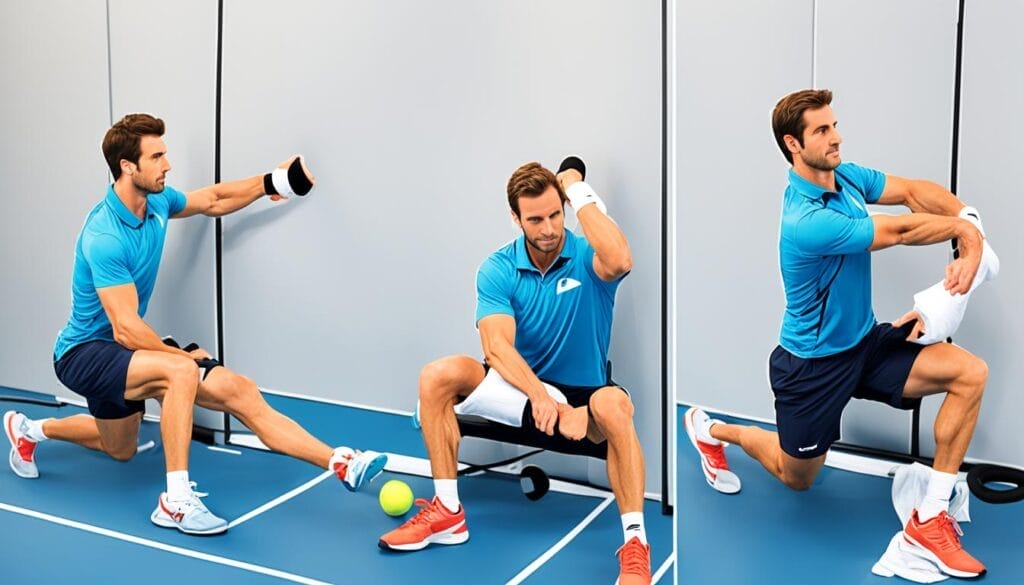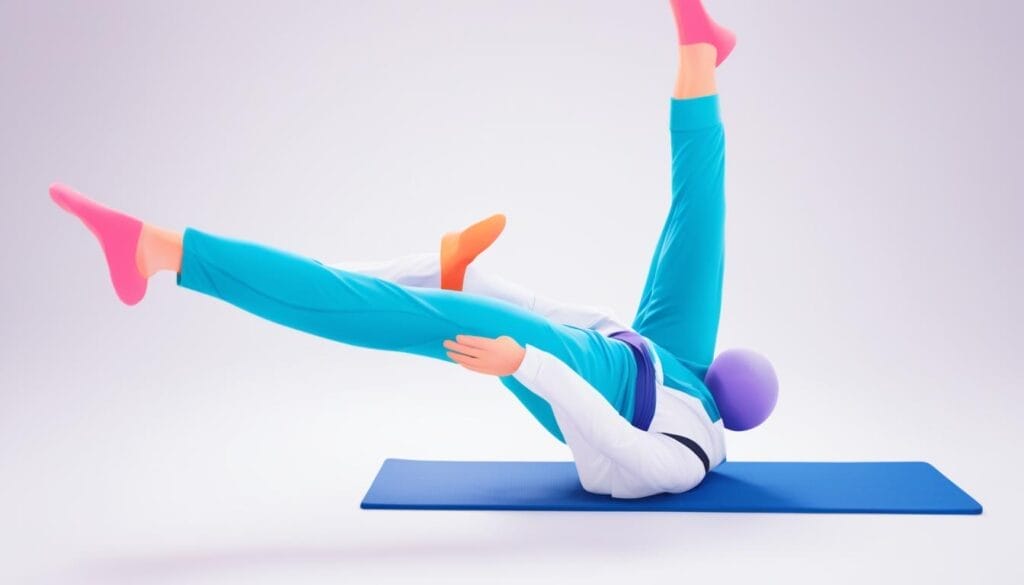Tennis is a sport that pushes your body to its limits. From fast sprints to quick footwork, it demands flexibility more than most sports.
When I started tennis, I found my flexibility lacking. It made me feel like I was held back in my game. It was then I realised how crucial flexibility is for us players.
Being flexible isn’t just good to have; it’s vital in tennis. It helps you hit that difficult shot and serve strong. Without it, quick changes in direction are hard, making you less likely to win and more prone to injuries.
So, how do you make yourself more flexible for tennis? In this article, I’ll tell you exercises and tips to up your flexibility game. No matter your level, these flexibility for tennis players methods will help you become more agile, mobile, and less likely to get hurt.
Key Takeaways
- Flexibility is crucial for optimal performance and injury prevention in tennis.
- Good flexibility enables effective maneuvering on the court and reduces the risk of muscle tears and connective tissue injuries.
- Flexibility plays a vital role in enabling faster movement, proper court positioning, and efficient recovery.
- Mobility exercises and targeted stretching routines are essential for improving flexibility and preventing injuries in tennis.
- Evaluating your mobility levels through regular assessments can help you identify areas of improvement and tailor your training program accordingly.
The Importance of Flexibility in Tennis
Flexibility in tennis is vital for a player’s game. It helps with agility, positioning on the court, and strength. Also, it’s key for avoiding overuse injuries common in tennis.
Being flexible means moving fast across the court and hitting hard-to-reach shots. It’s essential for covering the court well and placing shots strategically.
“Flexibility in tennis is like a secret weapon. It enables me to make those demanding on-court movements and reach for every ball. It also helps me recover faster between points and reduces the risk of muscle strains and tears. It’s a game-changer for a tennis player like me.” – Serena Williams
Good flexibility boosts on-court performance and recovery. It helps with blood flow, muscle tightness, and strength, making players bounce back faster after intense rallies.
Flexibility is crucial for staying away from injuries. It stops the strain on muscles and joints that lead to overuse injuries. Regular stretching can lower the risk of strains, sprains, and joint issues.
Below is a table showing how flexibility helps in tennis:
| Benefits of Flexibility in Tennis |
|---|
| Enables faster movement on the court |
| Facilitates proper court positioning |
| Aids in efficient recovery between points |
| Enhances overall strength and power |
| Reduces the risk of overuse injuries |
Flexibility is crucial in tennis. It makes players fast, helps them position right, recover well, and stay injury-free. Adding flexibility exercises to your training boosts your game and performance on the court.
Understanding Flexibility for Tennis Players
Flexibility is key in tennis. It lets players move in many ways on the court. It means muscles, joints, and soft tissues can move easily without pain.
Being flexible helps players reach for shots and bend low. They can also turn their bodies well. This is vital for better game play and fewer injuries. Good flexibility helps players move better and play their best.
In tennis, quick and agile moves in all directions are needed. Flexibility helps players perform these moves with balance. It’s important for actions like sprinting and stretching during a serve.
The Definition of Flexibility for Tennis Players
For tennis, flexibility is crucial. Players need the right movement in their joints and muscles for tennis moves. This lets them stretch for shots, recover quickly, and turn easily.
Flexibility also boosts shot power and consistency. It helps players swing the racket faster. This means stronger and more accurate shots.
It’s also vital for avoiding injuries. Tennis movements can strain the body. But with good flexibility, players face fewer risks of muscle injuries. This keeps them playing and away from recovery time.
How Flexibility Affects Tennis Performance
Flexibility hugely impacts tennis performance. It is linked to better movement, speed, and safety:
- More Motion Range: It allows full arm and leg motion for accurate strokes.
- Faster and Agile Moves: Flexibility means quick and smooth actions on court.
- Improved Court Reach: With flexibility, players get to wide shots easier and maintain their positions.
- Less Injury: It helps protect the body, meaning fewer muscle and joint issues.
Tennis players can reach their full potential by working on flexibility. This improves game play and cuts injury risks.

The Role of Mobility Exercises in Tennis
Dynamic stretching, or mobility exercises, is key to getting ready for tennis. They get your body moving smoothly and your joints loosened. This reduces the risk of injuries and improves your body’s ability to play.
Doing a mobility warm-up before tennis helps players move better and avoid getting hurts. It boosts how well you can move during the game. This means you can perform better and enjoy playing tennis more.
“Tennis mobility exercises are essential for warming up the muscles and joints before playing. They enhance range of motion, prepare the body for tennis-specific movements, and reduce the risk of injuries.”
Benefits of Mobility Exercises for Tennis Players
For tennis players, mobility exercises bring a lot of good. They help by:
- Improved range of motion: Playing tennis needs lots of moving. Doing these exercises helps you move better and reach those tough shots.
- Enhanced on-court performance: Moving quicker and covering more of the court is key. Better mobility means you perform better and win more points.
- Injury prevention: Tennis can strain your body. Doing mobility exercises before helps protect you from getting hurt. It gets your muscles ready and your joints moving smoothly.
How to Improve Mobility for Tennis
Want to get more mobile for tennis? Here’s what to do:
- Start with dynamic stretches to wake up your body.
- Work on key muscles like legs and core, important for tennis.
- Try moves that copy tennis actions, like side steps and twists.
- Make your exercises harder over time to keep improving.
- Do these exercises 2-3 times a week to stay on top of your game.
Adding focused mobility work can really help your tennis. It makes you move and play better. So, plan in these exercises and see how they boost your game.
Flexibility Exercises for Tennis Players
Improving how flexible you are is vital for tennis players. It boosts your performance and cuts down the chance of getting hurt on the court. By adding special flexibility moves to your workout, you can make your muscles longer and be quicker and better at standing on the court. Later, I’ll show you some good stretches to do after playing or at the end of the day. These will make you more flexible and help you play your best.
Tennis Flexibility Exercise 1: Hamstring Stretch
This stretch is great for the muscles on the back of your thighs. These muscles are key for hitting powerful tennis shots. Sit on the floor. Extend one leg in front and bend the other, its foot touching the inner thigh. Keep your back straight and lean towards your outstretched foot. You should feel a slight stretch in your thigh. Do this for 30 seconds on each leg, twice.
Tennis Flexibility Exercise 2: Shoulder and Chest Stretch
This stretch helps you move more freely with your upper body. It gets your shoulders and chest looser, perfect for smooth tennis moves. Stand up straight and link your fingers behind your back, palms in. Slowly raise your arms behind you. Keep your back straight and shoulders down. Feel your chest and shoulders stretch. Repeat this for 30 seconds, twice.
Tennis Flexibility Exercise 3: Quadricep Stretch
Quads are the muscles on the front of your thighs. They are important for staying steady on the court. Stand up straight. Grab one foot with your hand and bring it to your backside, your knee pointing down. Hold this pose for 30 seconds on each leg, twice.
Tennis Flexibility Exercise 4: Hip Flexor Stretch
The hip flexors are at the front of your hips. They tend to get tight from the motions in tennis. Get into a lunge with one knee on the ground and the other bent at a 90-degree angle. Slowly move your hips forward to feel the stretch. Do this for 30 seconds on each leg, twice.

Tennis Flexibility Exercise 5: Calf Stretch
Your calf muscles are super active during quick side-to-side moves on the tennis court. Face a wall and put both hands on it at about shoulder height. Step one foot back, keeping it straight, and press your heel to the floor. Lean into it, feeling your calf stretch. Hold this for 30 seconds on each leg, twice.
Stay with it and do these stretches often for tennis. It will make you more flexible, improve how you stand on the court, and cut the chance of hurting yourself. Always warm up before these stretches. And do them right to get the most out of them.
Targeted Stretches for Common Tennis Injuries
Tennis players often face injuries that can hurt their game. Adding specific stretches to your warm-up or cool-down can make a big difference. It helps prevent and reduce issues like tennis elbow, shoulder problems, and Achilles issues. These stretches focus on flexible and strong muscles, cutting down your injury risk.
Tennis stretches for common injuries zero in on the parts that tennis stresses a lot. By mixing still and moving stretches, you boost your body’s flexibility and power. This lowers your chances of getting hurt.
Stretches for Tennis Elbow
Tennis elbow is a painful arm injury from repetitive tennis movements. To help, try these stretches:
- Wrist Extension Stretch: Stretch your arm out, palm facing down. Use the other hand to gently pull your fingers towards you, stretching your forearm. Hold for 30 seconds, then switch arms.
- Forearm Pronation/Supination Stretch: With a light object in hand, bend your elbow at 90 degrees. Slowly turn your palm up and then down, feeling the stretch. Do this 10 times on each arm.
Shoulder Stretches for Tennis Players
Overhead movements in tennis can lead to shoulder issues. To keep your shoulders working well and prevent injuries, do these:
- Shoulder Cross-Body Stretch: Stand and stretch one arm straight across your chest. Use your other arm to gently pull it closer, feeling the shoulder stretch. Hold for 30 seconds each side.
- Shoulder External Rotation Stretch: Stand with your back to a wall, arm bent at 90 degrees. Put your forearm on the wall and press back gently, feeling your shoulder stretch. Hold for 30 seconds on each side.
Stretches for Achilles Tendon Injuries in Tennis
The back-of-the-ankle Achilles tendon can get hurt from tennis’s quick moves. To lower your Achilles injury risks, include these stretches:
- Calf Stretch: Face a wall and put one foot in front of the other. Lean forward, keeping your back leg straight, to stretch your calf. Hold for 30 seconds each leg.
- Toe Raises: Stand on a step with your heels off the edge. Go up on your toes, then lower below the step slowly. Do this 10 times to make your calf stronger and boost Achilles flexibility.
Adding these targeted stretches for common tennis injuries to your routine can make you more flexible and strong. It’s key to warm up before stretching and pay attention to how your body feels. Keep your body healthy so you can carry on playing tennis and do your best!
| Injury | Stretches |
|---|---|
| Tennis Elbow | Wrist Extension Stretch, Forearm Pronation/Supination Stretch |
| Shoulder Injuries | Shoulder Cross-Body Stretch, Shoulder External Rotation Stretch |
| Achilles Tendon Injuries | Calf Stretch, Toe Raises |

The Importance of Mobility Testing in Tennis
Mobility is crucial in tennis for playing better and avoiding injuries. All tennis players can gain a lot from tennis mobility testing. It helps you see where you can improve and make plans just for you.
Trainers or physiotherapists can check your mobility. They use tests and measurements to figure out your flexibility and strength. This lets them help you with areas you need to work on.
One great thing about mobility tests is they help you move better. You find out what parts of your body need more work. Then, you do exercises and stretches to fix them. By moving better, you play tennis better.
These tests can also stop you getting hurt. They look at your flexibility and how well your joints move. You learn which areas might get hurt and how to make them stronger. This lessens the chance of getting injured during playing or training.
So, how do they check your mobility for tennis? Here are a few ways:
- Range of motion tests check how well your joints move. They measure how far a joint can move.
- Functional movement tests see how well you can do tennis movements. They make sure your body moves right and find any issues.
- Flexibility tests find out how stretchy your muscles are. They show where you need to get better.
After checking, they make a programme just for you. It might have stretching exercises, mobility drills, and functional training. You should keep doing these and adjust as needed to get better.
Mobility testing is very important for tennis. It helps you move and play better while avoiding injuries. So, your tennis game can really step up.
Summing Up
Flexibility is key in tennis, boosting performance and preventing injuries. As a player, staying flexible is vital for moving well on the court. A good flexibility and mobility plan has really helped me improve.
Adding specific exercises and regular stretches to my routine improved flexibility. This lets me move better on the court. Checking my mobility has shown where I can get better. So, I’ve avoided more injuries and reached my tennis goals.
To my fellow tennis players, make flexibility and mobility your focus. Spend time stretching, do tennis target exercises, and keep an eye on your mobility. You’ll play better, stay safe, and have more fun playing tennis.
FAQ
Why is flexibility important for tennis players?
Being flexible is vital for tennis players. It lets them move well on the court and improves their strength. It also lowers the risk of getting hurt, like muscle tears.
What is the definition of flexibility in the context of tennis?
In tennis, being flexible means muscles and joints can move easily. This allows players to do different actions and moves while playing without pain.
How can mobility exercises benefit tennis players?
Mobility exercises help warm up the muscles and joints before a game. They also make the body ready for tennis. This can stop injuries from happening.
What are some flexibility exercises specifically for tennis players?
For tennis, doing fixed stretches is a good idea. They make your muscles more flexible. Do these after playing or before bed for the best impact.
Are there targeted stretches for common tennis injuries?
Yes, there are stretches for tennis injuries like tennis elbow or shoulder problems. These stretches ease tight muscles and reduce the chances of getting hurt.
How can mobility testing benefit tennis players?
Mobility tests show how well you can move and where you need to improve. They help make a plan for better movement. This stops injuries and makes you play better.
What is the importance of flexibility for tennis players?
Flexibility is key for tennis. It makes players do better, keeps them safe, and helps them move around the court well. This means they can do their best.
Source Links
Share Me:
READY TO UNLEASH
YOUR BEST SELF?
Click “Sign Me Up!” And Start Your Fitness Transformation!





